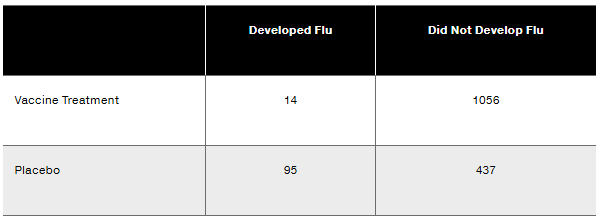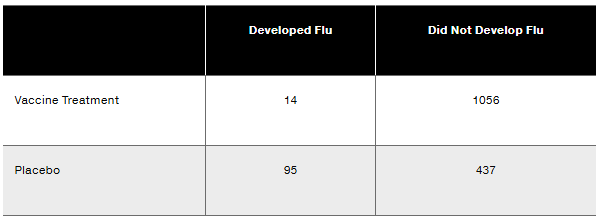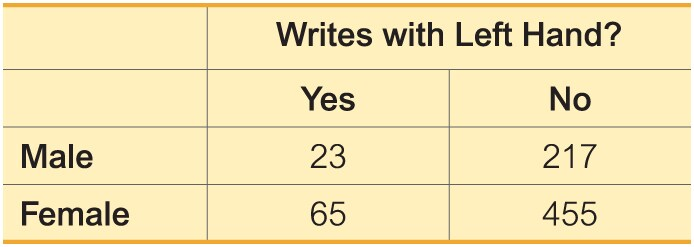 Back
BackProblem 4.CRE.4a
Sampling Eye Color Based on a study by Dr. P. Sorita Soni at Indiana University, assume that eye colors in the United States are distributed as follows: 40% brown, 35% blue, 12% green, 7% gray, 6% hazel.
a. A statistics instructor collects eye color data from her students. What is the name for this type of sample?
Problem 4.CRE.5
Heights of Presidents Theories have been developed about the heights of winning candidates for the U.S. presidency and the heights of candidates who were runners up. Listed below are heights (cm) from recent presidential elections. Construct a graph suitable for exploring an association between heights of presidents and the heights of the presidential candidates who were runners-up. What does the graph suggest about that association?
Problem 4.CRE.1cd
Cloud Seeding The “Florida Area Cumulus Experiment” was conducted by using silver iodide to seed clouds with the objective of increasing rainfall. For the purposes of this exercise, let the daily amounts of rainfall be represented by units of rnfl. (The actual rainfall amounts are in or )
Find the value of the following statistics and include appropriate units based on rnfl as the unit of measurement.
[Image]
c. midrange
d. range
Problem 4.CRE.1ab
Cloud Seeding The “Florida Area Cumulus Experiment” was conducted by using silver iodide to seed clouds with the objective of increasing rainfall. For the purposes of this exercise, let the daily amounts of rainfall be represented by units of rnfl. (The actual rainfall amounts are in or )
Find the value of the following statistics and include appropriate units based on rnfl as the unit of measurement.
15.53 7.27 7.45 10.39 4.70 4.50 3.44 5.70 8.24 7.30 4.05 4.46
a. mean
b. median
Problem 4.RE.4
In Exercises 1–10, use the data in the accompanying table and express all results in decimal form. (The data are from “The Left-Handed: Their Sinister History,” by Elaine Fowler Costas, Education Resources Information Center, Paper 399519.)
Lefty or Female Find the probability of randomly selecting one of the study subjects and getting someone who writes with their left hand or is a female.
Problem 4.q.1
ESP A psychologist tells you that in an ESP (extrasensory perception) experiment, there is a 20% chance of answering a question correctly. What is the probability of answering a question correctly?
Problem 4.q.5
Subjective Probability Estimate the probability that the next time you watch a TV news report, it includes a story about a plane crash.
Problem 4.q.6
In Exercises 6–10, use the following results from tests of an experiment to test the effectiveness of an experimental vaccine for children (based on data from USA Today). Express all probabilities in decimal form.
If 1 of the 1602 subjects is randomly selected, find the probability of getting 1 that developed flu.
Problem 4.q.8
In Exercises 6–10, use the following results from tests of an experiment to test the effectiveness of an experimental vaccine for children (based on data from USA Today). Express all probabilities in decimal form.
If 1 of the 1602 subjects is randomly selected, find the probability of getting 1 who had the vaccine treatment and developed flu.
Problem 4.r.12d
Vision Correction About 75% of the U.S. population uses some type of vision correction (such as glasses or contact lenses).
d. If you randomly select four people, is a result of all four using vision correction significantly high? Why or why not?
Problem 4.r.13b
National Statistics Day
b. If a person is randomly selected, find the probability that his or her birthday is in October. Ignore leap years.
Problem 4.c.3b
Organ Donors USA Today provided information about a survey (conducted for Donate Life America) of 5100 adult Internet users. Of the respondents, 2346 said they are willing to donate organs after death. In this survey, 100 adults were surveyed in each state and the District of Columbia, and results were weighted to account for the different state population sizes.
b. Based on the poll results, what is the probability of randomly selecting an adult who is willing to donate organs after death?
Problem 4.q.2
Standard Tests Standard tests, such as the SAT or ACT or MCAT, tend to make extensive use of multiple-choice questions because they are easy to grade using software. If one such multiple choice question has possible correct answers of a, b, c, d, e, what is the probability of a wrong answer if the answer is a random guess?
Problem 4.r.8
In Exercises 1–10, use the data in the accompanying table and express all results in decimal form. (The data are from “The Left-Handed: Their Sinister History,” by Elaine Fowler Costas, Education Resources Information Center, Paper 399519.)
Complement If L represents the event of randomly selecting one of the study subjects and getting someone who writes with their left hand, what does L represent? Find the value of P(L)
Problem 4.c.4d
Sampling Eye Color Based on a study by Dr. P. Sorita Soni at Indiana University, assume that eye colors in the United States are distributed as follows: 40% brown, 35% blue, 12% green, 7% gray, 6% hazel.
d. If two people are randomly selected, what is the probability that at least one of them has brown eyes?
Problem 4.RE.12b
Vision Correction About 75% of the U.S. population uses some type of vision correction (such as glasses or contact lenses).
b. If four different people are randomly selected, what is the probability that they all use vision correction?
Problem 4.CQQ.9
In Exercises 6–10, use the following results from tests of an experiment to test the effectiveness of an experimental vaccine for children (based on data from USA Today). Express all probabilities in decimal form.
Find the probability of randomly selecting 2 subjects without replacement and finding that they both developed flu.
Problem 4.RE.7
In Exercises 1–10, use the data in the accompanying table and express all results in decimal form. (The data are from “The Left-Handed: Their Sinister History,” by Elaine Fowler Costas, Education Resources Information Center, Paper 399519.)
Both Lefties If two of the study subjects are randomly selected with replacement, find the probability that they both write with their left hand.
Problem 4.1.27b
In Exercises 21-28, find the probability and answer the questions.
Genetics: Eye Color Each of two parents has the genotype brown/blue, which consists of the pair of alleles that determine eye color, and each parent contributes one of those alleles to a child. Assume that if the child has at least one brown allele, that color will dominate and the eyes will be brown. (The actual determination of eye color is more complicated than that.)
b. What is the probability that a child of these parents will have the blue/blue genotype?
Problem 4.1.21
In Exercises 21-28, find the probability and answer the questions.
YSORT Gender Selection MicroSort’s YSORT gender selection technique is designed to increase the likelihood that a baby will be a boy. At one point before clinical trials of the YSORT gender selection technique were discontinued, 291 births consisted of 239 baby boys and 52 baby girls (based on data from the Genetics & IVF Institute). Based on these results, what is the probability of a boy born to a couple using MicroSort’s YSORT method? Does it appear that the technique is effective in increasing the likelihood that a baby will be a boy?
Problem 4.1.23
In Exercises 21-28, find the probability and answer the questions.
Mendelian Genetics When Mendel conducted his famous genetics experiments with peas, one sample of offspring consisted of 428 green peas and 152 yellow peas. Based on those results, estimate the probability of getting an offspring pea that is green. Is the result reasonably close to the expected value of as Mendel claimed?
Problem 4.1.24b
In Exercises 21-28, find the probability and answer the questions.
Guessing Birthdays On their first date, Kelly asks Mike to guess the date of her birth, not including the year.
b. Would it be unlikely for him to guess correctly on his first try?
Problem 4.1.3a
Dice and Coins
a. Find the probability that when a single six-sided die is rolled, the outcome is 5.
Problem 4.1.25
In Exercises 21-28, find the probability and answer the questions.
Social Networking In a Pew Research Center survey of Internet users, 3732 respondents say that they use social networking sites and 1380 respondents say that they do not use social networking sites. What is the probability that a randomly selected person uses a social networking site? Does that result suggest that it is likely (with a probability of 0.5 or greater) for someone to use social networking sites?
Problem 4.1.28a
In Exercises 21-28, find the probability and answer the questions.
X-Linked Genetic Disease Men have XY (or YX) chromosomes and women have XX chromosomes. X-linked recessive genetic diseases (such as juvenile retinoschisis) occur when there is a defective X chromosome that occurs without a paired X chromosome that is not defective. In the following, represent a defective X chromosome with lowercase x, so a child with the xY or Yx pair of chromosomes will have the disease and a child with XX or XY or YX or xX or Xx will not have the disease. Each parent contributes one of the chromosomes to the child.
a. If a father has the defective x chromosome and the mother has good XX chromosomes, what is the probability that a son will inherit the disease?
Problem 4.1.28c
In Exercises 21-28, find the probability and answer the questions.
X-Linked Genetic Disease Men have XY (or YX) chromosomes and women have XX chromosomes. X-linked recessive genetic diseases (such as juvenile retinoschisis) occur when there is a defective X chromosome that occurs without a paired X chromosome that is not defective. In the following, represent a defective X chromosome with lowercase x, so a child with the xY or Yx pair of chromosomes will have the disease and a child with XX or XY or YX or xX or Xx will not have the disease. Each parent contributes one of the chromosomes to the child.
c. If a mother has one defective x chromosome and one good X chromosome and the father has good XY chromosomes, what is the probability that a son will inherit the disease?
Problem 4.1.29
In Exercises 29–32, use the given sample space or construct the required sample space to find the indicated probability.
Three Children Use this sample space listing the eight simple events that are possible when a couple has three children (as in Example 2): {bbb, bbg, bgb, bgg, gbb, gbg, ggb, ggg}. Assume that boys and girls are equally likely, so that the eight simple events are equally likely. Find the probability that when a couple has three children, there is exactly one girl.
Problem 4.1.31
In Exercises 29–32, use the given sample space or construct the required sample space to find the indicated probability.
Four Children Exercise 29 lists the sample space for a couple having three children. After identifying the sample space for a couple having four children, find the probability of getting three girls and one boy (in any order).
Problem 4.1.34
In Exercises 33–40, use the given probability value to determine whether the sample results are significant.
Voting Repeat the preceding Exercise 33 after replacing 40 Democrats being placed on the first line of voting ballots with 26 Democrats being placed on the first line. The probability of getting a result as high as 26 is 0.058638.
Problem 4.1.35
In Exercises 33–40, use the given probability value to determine whether the sample results are significant.
Voting Repeat Exercise 33 after replacing 40 Democrats being placed on the first line of voting ballots with 14 Democrats being placed on the first line. The probability of getting a result as low as 14 is 0.029792.







